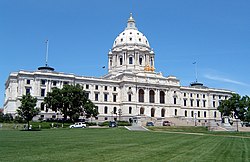| 21 | None | Incumbent DFLer and then-Senate President Alec G. Olson had been reelected during the General Election of 1976. However, during the same election cycle, U.S. Senator Walter Mondale was elected Vice President of the United States, causing Mondale to resign from the U.S. Senate. Governor Wendell Anderson proceeded to appoint himself to Mondale's vacated seat, which caused Lieutenant Governor Rudy Perpich to succeed to the office of Governor, and hence created a vacancy in the office of Lieutenant Governor. As per the provisions of the Minnesota Constitution, Olson, as the last-elected President of the Senate, then succeeded to the office of Lieutenant Governor, causing him to automatically resign his seat in the Minnesota Senate effective December 29, 1976. Thus, this seat was already vacant when the 70th Legislature convened. | A. O.H. Setzepfandt
(DFL) | February 15, 1977 [10] |
